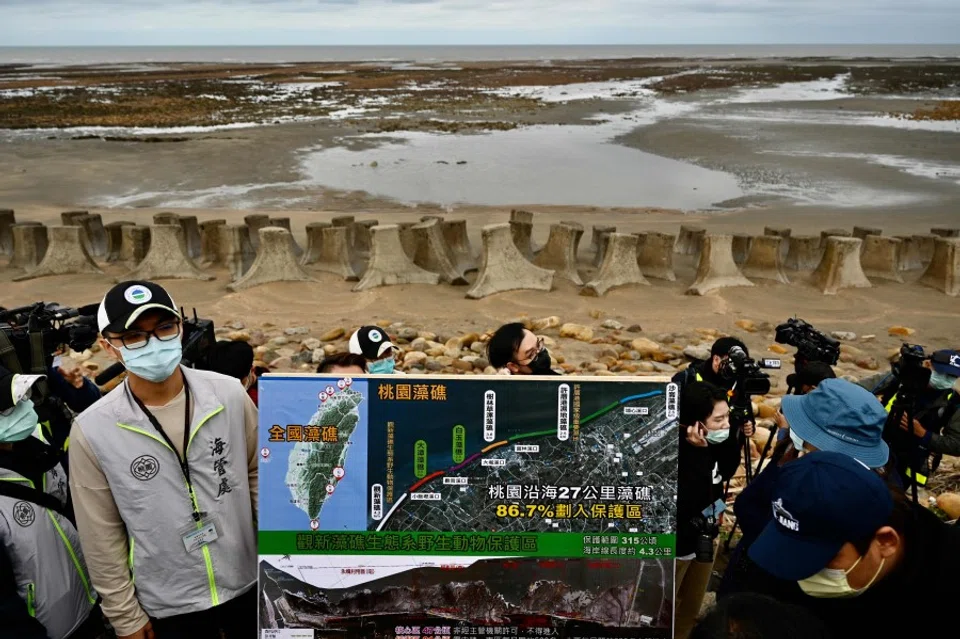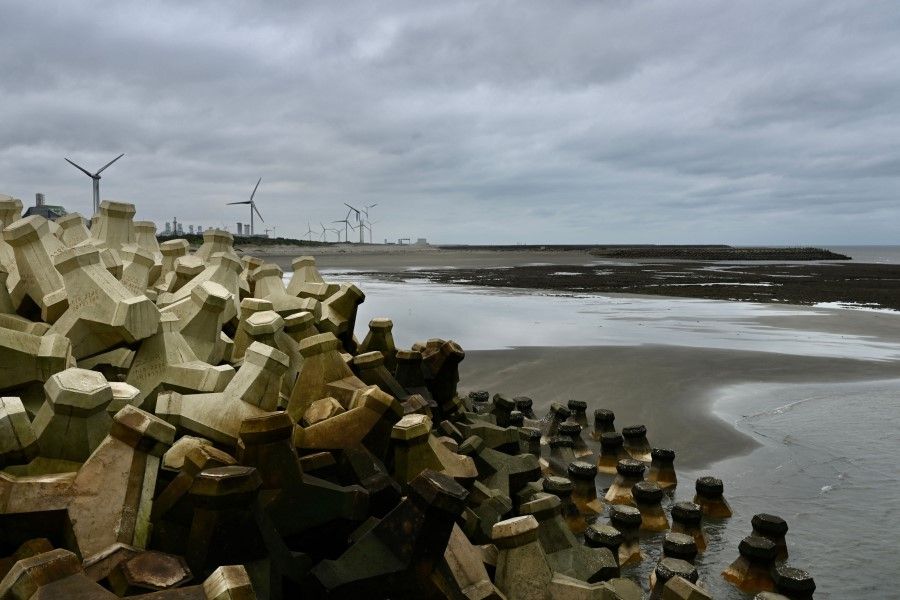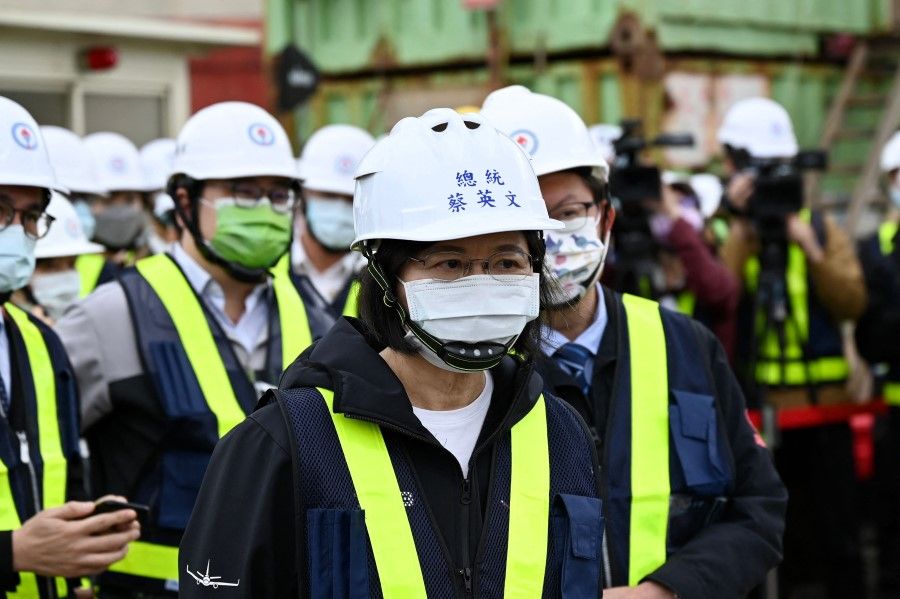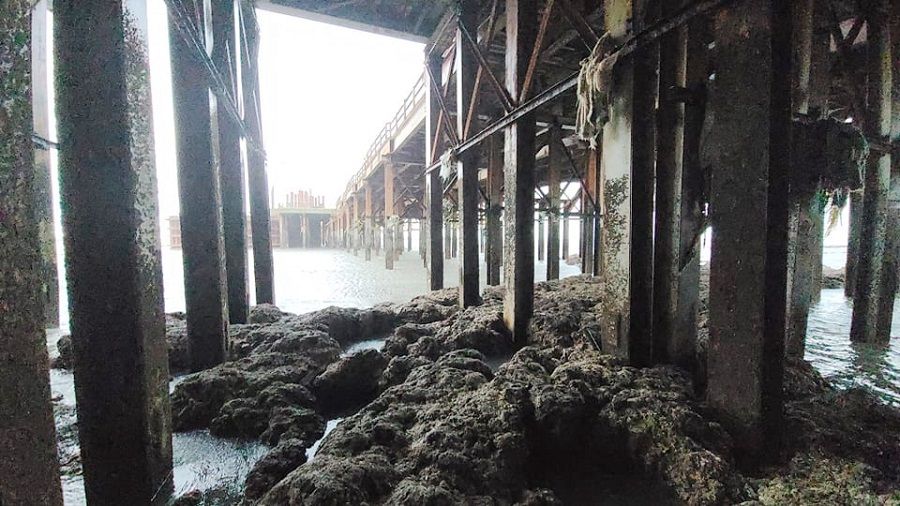Taiwan's algal reef referendum: A proxy for political battle?

On the windy, sandy Taoyuan coastline in northwest Taiwan is a large, 27-kilometre algal reef made up of mostly coral algae, which clings to rocks and glues corals and shells together to form this unique shallow water reef.
Algal reefs are a valuable natural heritage that grow just one centimetre in 20 years according to studies, which means it took 7,600 years for the Taiwan reef to get to what it is today. It is a natural barrier for Taiwan and a habitat for rare marine life including the critically endangered Polycyathus chaishanensis coral, and the vulnerable Eriphia crabs and Grapsus albolineatus crab.
To alleviate Taiwan's power shortage issues, in 2014, the Ministry of Economic Affairs proposed a third liquefied natural gas (LNG) terminal at Guantang Industrial Park, off the coast of the Datan algal reef, with the construction to be managed by CPC Corp, Taiwan.
Conservation groups protested, and both sides said their piece as they held discussions with no consensus.
The petition calls for the LNG terminal to be relocated away from the Datan reef and waters, with existing development projects to be removed and not to be resumed.

Out of the 27-kilometre algal reef, the Datan reef is considered the stretch that is most complete with the most diverse life, but now it is threatened by development projects. In contrast, the nearby Guanxin reef was turned into the highly protected Guanxin Algal Reefs Ecosystem Wildlife Refuge in 2014.
On 18 March this year, conservation groups submitted 703,504 signatures to the Central Election Commission in support of a referendum on the LNG terminal; this national referendum will be held on 18 December, one of a total of four referendums to be held that day.
The petition calls for the LNG terminal to be relocated away from the Datan reef and waters, with existing development projects to be removed and not to be resumed.
Taiwan's Minister of Economic Affairs Wang Mei-hua explained in a televised opinion presentation that the LNG terminal would not only take care of power supply, but would also help reduce pollution and protect the reef. The Economic Affairs Ministry said the new solution adjusted in 2018 already avoids the reef and significantly reduces the area of development; this year's solution pushes the industrial zone about 1.2 kilometres away from the shore, and even further away from the reef, so that the LNG terminal can operate practically all year round.

The Taiwan government is sticking to building the LNG station at the Datan reef as soon as possible, to ensure a stable power supply. Wang Mei-hua stressed that if the LNG station was moved, Taiwan would have to burn an additional 5 million tonnes of fuel each year to meet power needs, which would worsen air pollution.
For the four referendums, the Democratic Progressive Party (DPP) government used a large amount of administrative resources, mobilising party officials and public representatives to go all over and rally people to their cause - the original plan was for 300 sessions, which mushroomed to 2,100 sessions. The pro-establishment Blue camp and pro-democratic Green camp are going at each other full force, on the "four points of disagreement": nuclear power, pork imports, conservation of algal reefs and whether future referendums should be held on the same day as major elections.
Several recent surveys show that the DPP is anxious to catch up. A majority of people object to nuclear power, while the referendum on the reef is hanging by a thread, after an initial lead for those in favour of the power station. A survey by my-formosa.com showed 41.1% of people voting no, while the proportion of those in favour has fallen to 35%, with a majority of people wanting to move the LNG station to protect the reef.
...should the referendum be passed, the DPP's energy transition policy would be severely affected while the KMT would earn extra points and have their confidence boosted for the 2022 mayoral election and 2024 presidential election.

KMT-supported referendums a threat to the DPP
The algal reef referendum put forth by environmental groups is also supported by the Kuomintang (KMT), the largest opposition party. It is generally believed that should the referendum be passed, the DPP's energy transition policy would be severely affected while the KMT would earn extra points and have their confidence boosted for the 2022 mayoral election and 2024 presidential election.
As environmental protection is everyone's consensus, the DPP did not engage in a head-on confrontation nor outrightly use the words "oppose the Cherish Algal Reefs Referendum". It only emphasised that it opposed the referendum on the relocation of the third LNG terminal.
However, 69-year-old Pan Chong-cheng, a retired teacher and convener of the Algae Reef Reservation Alliance, thinks that the Cherish Algal Reefs Referendum is like a "boomerang" that will challenge the realist ways of the DPP, who put the interests of consortiums and factions above its environment pledges once it became the ruling party.
He told Zaobao that before President Tsai Ing-wen took office, she had visited the Guanxin Algal Reefs Ecosystem Wildlife Refuge in 2013 where she wrote the words "藻礁永存" (meaning, "long live algal reefs"). Now, she is saying that the algal reefs at Guanxin have already survived (观新藻礁已永存); implying that the promise to protect algal reefs has been fulfilled, and ignoring the fact that the Guanxin algae reef area is only a part of the algal reef ecosystem in Taoyuan. She even said that the third LNG terminal is not actually built on any algal reef.
On the morning of 7 December, KMT legislator Lee De-wei and Pan surveyed the trestle construction site and photographed the actual situation where concrete had covered the algal reefs and iron frames were directly inserted into them, giving strong evidence to the contrary.

Taiwan's Ministry of Economic Affairs later admitted that the seven piers under the trestle bridge of the development project have already destroyed 0.4 hectares of algal reefs, to which the Executive Yuan quickly clarified that they were built on rocky reefs and not algal reefs. On the morning of 7 December, KMT legislator Lee De-wei and Pan surveyed the trestle construction site and photographed the actual situation where concrete had covered the algal reefs and iron frames were directly inserted into them, giving strong evidence to the contrary.
Pan also pointed out that in 2014 when Cheng Wen-tsan was still a candidate running for Taoyuan mayor, he had pledged to protect the algal reefs and said that he would never compromise on the matter. Now, he has retracted his pledge and accused environmental groups of using algal reefs to "blackmail Taiwan".
Pan hoped that the people of Taiwan would demand the truth through the referendum and put the integrity of the leaders to the test. He urged people to put aside ideological differences and pan-Blue and pan-Green divisions to respond to "the call of the algal reefs", make deliberate choices for the welfare and environmental sustainability of the next generation, and "create a new milestone" for Taiwan's democratic society.
However, when the proponents and the opposers give contradictory remarks to basic facts, it becomes harder to discern if the algal reef referendum - as Taiwan's first ecological referendum - is a battle between the economy and environmental protection or a debate over who is speaking the truth. While most people heading to vote on 18 December may stand on the side of environmental protection, whether they are voting for the proponents or the opposers is likely a different story.

Some facts about the Cherish Algal Reefs Referendum
- Taiwan generates most of its electricity from natural gas, which accounted for 40.8% of Taiwan's total electricity in 2020.
- An LNG receiving terminal is a facility that stores liquefied natural gas for transportation. Taiwan has two existing LNG terminals: one at the Port of Taichung and another at Kaohsiung's Yong'an District. Environmental assessment is in progress for a fourth terminal at Keelung and a fifth terminal at the Port of Taichung's outer harbour expansion.
- During her re-election campaign, Taiwan President Tsai Ing-wen proposed the "2025 Non-Nuclear Homeland" energy policy, which pledged to raise the percentage of natural gas to 50% and renewable energy to 20%, and lower the use of coal to 30%. At present, renewable energy only accounts for 5.8% of Taiwan's electricity supply, while nuclear power accounts for 12.7%, coal accounts for 36.4%, and natural gas accounts for 40.8%. The remaining 4.3% includes fuel, pumped storage, and combined heat and power. If Taiwan abandons the "Go Green with Nuclear" (以核养绿) plan, and the third LNG terminal fails to be built, this promise will certainly be unfulfilled.
